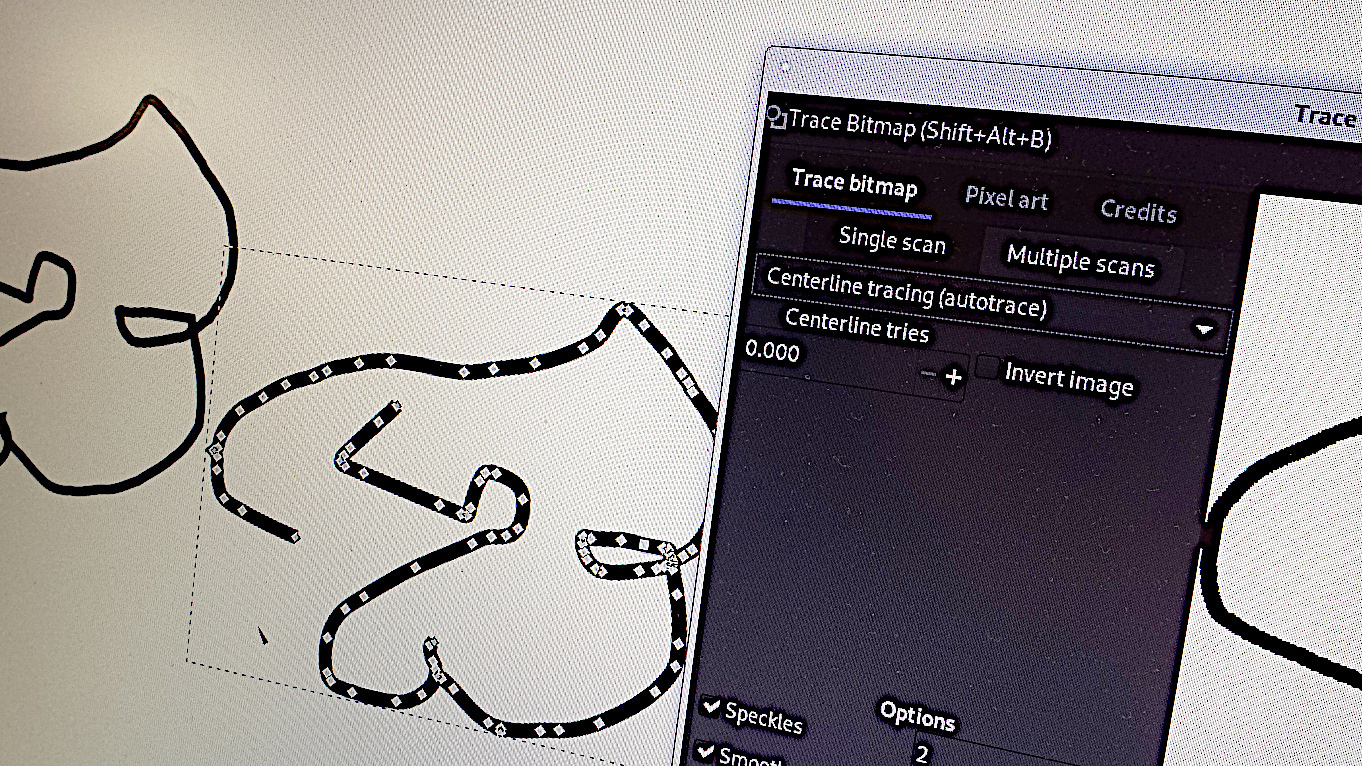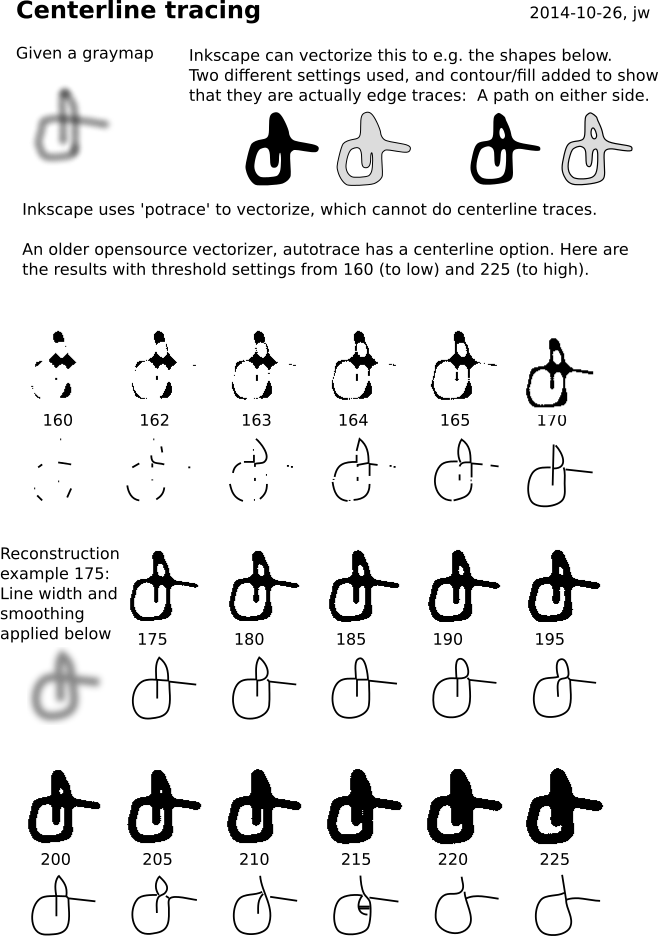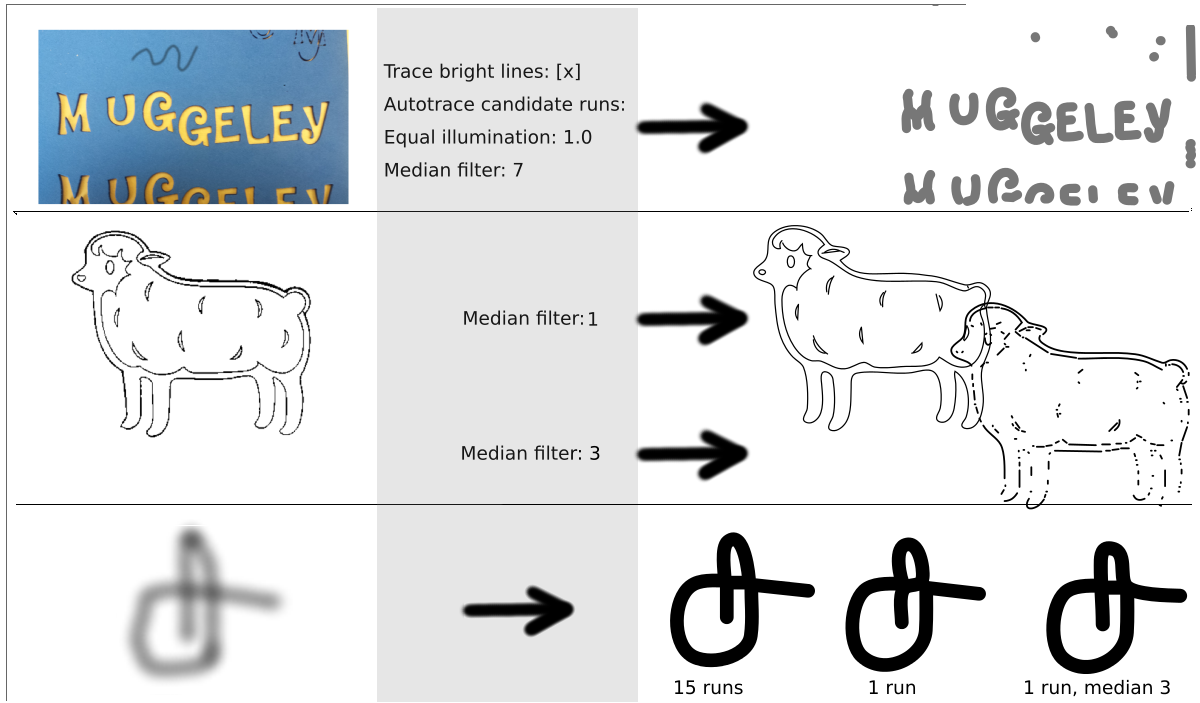inkscape-centerline-trace
A bitmap vectorizer that can trace along the centerline of a stroke. The builtin inkscape 'trace bitmap' can only trace edges, thus resulting in double lines for most basic use cases.
Download Source code and Debian/Ubuntu package
NOTE: This is python2 code. It was developed and tested with inkscape-0.92.3 -- It probably does not run with inkscape 1.0.1 and should not be needed. Inkscape 1.0.1 has the feature built-in under Path -> Trace Bitmap -> Centerline tracing (autotrace)
Written with python-Pillow. It uses 'autotrace -centerline' and an optimal threshold to vectorize a pixel image. See centerline-tracing.svg for an illustration of the idea.
In inkscape it shows up under Extensions -> Images -> Centerline Trace ...
Installation hints
-
Install the extension (all operating systems)
- the extension requires the installation of autotrace and python-pil (see below)
- grab a binary package or
- download the zip file of inkscape-centerline-trace and unpack it
- copy the files centerline-trace.inx, centerline-trace.py to your Inkscape User extensions folder (see Edit > Preferences > System: System info: User extensions)
-
Install autotrace / python-pil
- Windows
- Instructions for Inkscape 0.92.2 and higher:
- Install autotrace win64-setup.zip version 0.40.0 or later from e.g. https://github.com/autotrace/autotrace/releases
Make sure the installation path is C:\Program Files (x86)\AutoTrace -- this application searches there.
- Older version: autotrace binary from autotrace-win64-binaries github repo) Copy the downloaded autotrace.exe to Inkscape's User extensions folder, that should also work.
- Install autotrace win64-setup.zip version 0.40.0 or later from e.g. https://github.com/autotrace/autotrace/releases
Make sure the installation path is C:\Program Files (x86)\AutoTrace -- this application searches there.
- Instructions for Inkscape 0.92: https://inkscape.org/en/gallery/item/10567/centerline_NIH0Rhk.pdf
- Instructions for Inkscape 0.92.2 and higher:
- MacOS
- Install autotrace MacOS.zip version 0.40.0 or later from e.g. https://github.com/autotrace/autotrace/releases
- open a command line shell to install the python-PIL module:
sudo easy_install install pipsudo pip install pillow
- open a command line shell to install the inkscape extension:
cd ~/.config/inkscape/extensionscurl https://raw.githubusercontent.com/fablabnbg/inkscape-centerline-trace/master/centerline-trace.py -o centerline-trace.pycurl https://raw.githubusercontent.com/fablabnbg/inkscape-centerline-trace/master/centerline-trace.inx -o centerline-trace.inx
- Please report success in the github issues. As of 2018-08-31, MacOS Support is back, but highly experimental.
- GNU/Linux
- Install the autotrace DEB package version 0.40.0 or later from e.g. https://github.com/autotrace/autotrace/releases
- if you do not have pillow/pil installed, the extension will output an error message prompting you to install it. On Ubuntu and derivatives, run
sudo apt-get install python-pilto install.
- Windows
-
Finally, restart inkscape, and find CenterlineTrace in the
Extensions -> Imagesmenue. -
Since Inkscape 1.0 the Autotrace library including the CenterlineTrace feature is integrated. That should obsolete this extension. Find an entry in the new
Path -> Trace Bitmapdialog.

Algorithm
The input image is converted to a graymap and histogram normalized with PIL.ImageOps.autocontrast. Optional preprocessing: equal illumination, median denoise filter.
Autotrace needs a bi-level bitmap. In order to find the best threshold value, we can run autotrace at multiple thresholds and evaluate the result candidates.
We count the number of line segments produced and measure the total path length drawn. The svg that has the longest path but the least number of segments is returned.

